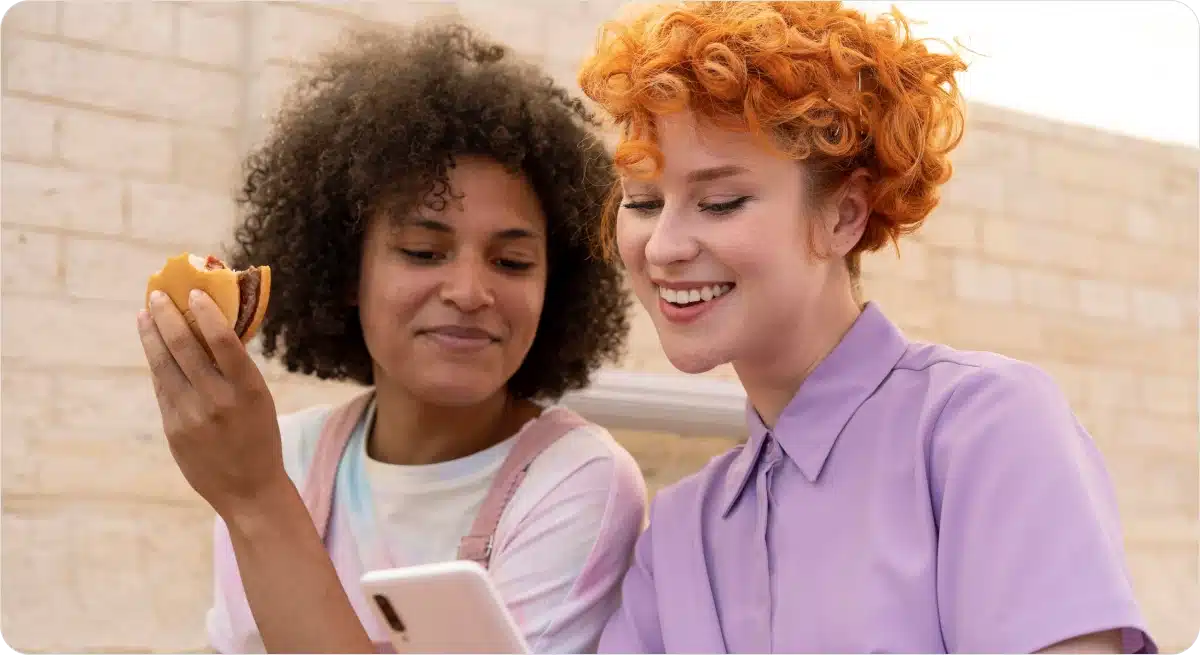




Generation Z – those born between 1997 to 2012 – are a perfect fit for second-screen experiences. Appealing to Gen Z preferences matters because they’re already 20% of the US population. Meeting their needs and expectations is vital to maintain and grow your audience.
What Is A Second-Screen Experience?
A second-screen experience means switching back and forth between two different screens, usually digital devices. The best second-screen experiences share two aspects: two different devices and audience behavior.
A second-screen experience starts with using two screen devices. For example, you might watch a show on a streaming service on your TV and then discuss it with friends on your mobile device.
However, switching back and forth between devices isn’t necessarily a sign of high engagement. For example, a viewer who checks their email during a TV show’s commercial break is relatively disengaged. In contrast, a viewer who uses their device to find out more about an ad is more likely to get invested in advertising.
Attracting and keeping Gen Z’s attention to a program takes more than excellent writing, acting, and more. Success requires leveraging second-screen engagement strategies. In a previous post, we covered popular second-screen engagement strategies.
Download our white paper “Generation Z and the Rise of the Second Screen” and transform your engagement strategy today.
The 5 Reasons Gen Z Audiences Love Second-Screen
Gen Z’s enthusiasm for second-screen experiences and engagement is positioned to grow further for a few reasons.
1) They’re Passionate About Social Media

As digital natives, Gen Z’s passion for social media is well documented. As of 2022, the top two most popular social media platforms – as measured by the number of hours spent per month – for this demographic are TikTok (23.6 hours) and YouTube (23.2 hours). Video and social connections are the common denominators between those platforms.
This means that Gen Z audiences are likely using social media while watching TV and other screen experiences. View that habit as an opportunity to connect with them while they’re watching.
2) Multi-tasking Is A Default Gen Z Behavior

Multi-tasking – or rapidly switching between tasks – is another common Gen Z habit. Nearly two-thirds (64%) of Gen Z view multi-tasking as an “essential life skill” compared to 51% of Boomers. This tendency has its advantages and disadvantages.
For brands and publishers seeking to grow Gen Z engagement, multi-tasking means offering a varied experience is essential. Expecting Gen Z to stay focused entirely on a single screen (or any activity) for a full hour is probably unrealistic.
Lean into this multi-tasking behavior by offering Gen Z audiences several ways to engage with you. For example, offer a live chat experience on your website to supplement the audience experience. For example, a chat experience focused on the World Series is a great way to keep viewers engaged in the action, even when the broadcast is on a commercial break.
3) Gen Z Audiences Expect Personalization

Personalization is a default experience for many digital experiences like online shopping, social media, and other platforms. A 2023 study of more than 1500 Gen Z respondents in Europe found that 45% of Gen Z expect personalization. That’s not all. Almost half (45%) of Gen Z will leave a website if it doesn’t predict their needs and cater to them.
Meeting the demand for personalized experiences with a single screen – like a TV alone – takes time and effort. Even the big streaming platforms offer limited personalization, such as customized recommendations. Tailoring content suggestions is necessary, but more is needed to connect with Gen Z. To connect further with Gen Z audiences (and earn first-party data), see our post: 5 Ways Publishers Can Build Their Gen Z Audience And Earn First Party Data.
Personalization must also extend to advertising. Without relevance, Gen Z is likely to tune out completely. A second-screen experience is one way out of this dilemma because a second-screen (i.e., a mobile device or computer) can leverage valuable first–party data to deliver more personalized experiences.
Fulfilling Gen Z expectations for highly personalized experiences is only possible with robust data. If you’re new to the world of first-party data, see our guide: What is first-party data?
4) Gen Z Is The Same-day Shipping Generation

In 2015, Amazon launched same-day shipping for 14 cities across the US. That means that Gen Z were teenagers or younger when this new level of instant gratification became widely available. For comparison, prior generations were used to waiting much longer – weeks for mail-order purchases – for purchases to appear.
It’s not just a question of shipping expectations. Generation Z audiences are unlikely to sit through long waits. This has a few implications for designing second-screen experiences.
TV to second screen transition
Gen Z audiences expect instant gratification when they see something they like or want to discuss. In many cases, social media platforms provide that social outlet.
Website/App speed
Speed is critical if Gen Z sees an ad or finds your website differently while viewing their primary screen. In a second-screen context, Gen Z users will rapidly switch between your website on their phone and their other screen.
A live chat experience on your website is a great way to capture Gen Z’s attention in these situations. Ensure your live chat solution is lightweight and fast, like Arena Live Chat.
5) Gen Z Expects Innovation

Gen Z’s expectations for innovation are significant for a few reasons. Since they’ve grown up in the digital era, they have seen rapid development. Many in Gen Z may not see the original 2007 iPhone as particularly innovative because smartphones have been commonplace for most of their lives.
Well-crafted second-screen experiences have been around for a few years. Yet, these experiences are far from universal today. That means there is still a tremendous opportunity to deliver innovation and novel experiences through second screens.
Use a second screen to offer better marketing campaigns – see an ad on TV and then customize the product before ordering it on a smartphone. Alternatively, live broadcast events can use feedback – like chat comments and voting in polls – to shape their programming. For example, picture a Reddit-style “ask me anything” interview where the audience upvotes their favorite questions for a celebrity.
How To Unlock Gen Z Engagement Faster
Meeting Gen Z expectations like instant gratification, innovation, and more might feel challenging! There are ways to make it easier, though. Add a live chat app to your website, and you’ll be ready to build an engaging second-screen experience soon. Find out more about building a digital community with Arena.



